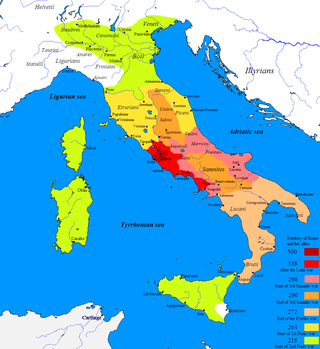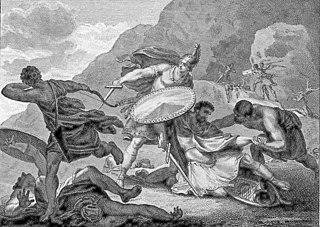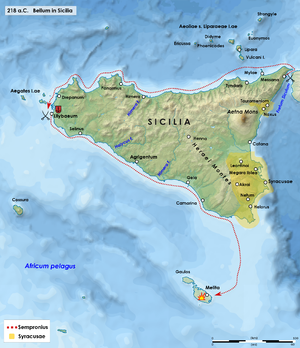
The First Punic War was the first of three wars fought between Rome and Carthage, the two main powers of the western Mediterranean in the early 3rd century BC. For 23 years, in the longest continuous conflict and greatest naval war of antiquity, the two powers struggled for supremacy. The war was fought primarily on the Mediterranean island of Sicily and its surrounding waters, and also in North Africa. After immense losses on both sides, the Carthaginians were defeated and Rome gained territory from Carthage.

The Second Punic War was the second of three wars fought between Carthage and Rome, the two main powers of the western Mediterranean in the 3rd century BC. For 17 years the two states struggled for supremacy, primarily in Italy and Iberia, but also on the islands of Sicily and Sardinia and, towards the end of the war, in North Africa. After immense materiel and human losses on both sides, the Carthaginians were once again defeated. Macedonia, Syracuse and several Numidian kingdoms were drawn into the fighting, and Iberian and Gallic forces fought on both sides. There were three main military theatres during the war: Italy, where Hannibal defeated the Roman legions repeatedly, with occasional subsidiary campaigns in Sicily, Sardinia and Greece; Iberia, where Hasdrubal, a younger brother of Hannibal, defended the Carthaginian colonial cities with mixed success before moving into Italy; and Africa, where Rome finally won the war.

Year 218 BC was a year of the pre-Julian Roman calendar. At the time it was known as the Year of the Consulship of Scipio and Longus. The denomination 218 BC for this year has been used since the early medieval period, when the Anno Domini calendar era became the prevalent method in Europe for naming years.
Hamilcar Barca or Barcas was a Carthaginian general and statesman, leader of the Barcid family, and father of Hannibal, Hasdrubal and Mago. He was also father-in-law to Hasdrubal the Fair.

The Battle of Lake Trasimene was fought when a Carthaginian force under Hannibal Barca ambushed a Roman army commanded by Gaius Flaminius on 21 June 217 BC, during the Second Punic War. The battle took place on the north shore of Lake Trasimene, to the south of Cortona, and resulted in a heavy defeat for the Romans.
The Battle of the Aegates was a naval battle fought on 10 March 241 BC between the fleets of Carthage and Rome during the First Punic War. It took place among the Aegates Islands, off the western coast of the island of Sicily. The Carthaginians were commanded by Hanno, and the Romans were under the overall authority of Gaius Lutatius Catulus, but Quintus Valerius Falto commanded during the battle. It was the final and deciding battle of the 23-year-long First Punic War.

The Mercenary War, also known as the Truceless War, was a mutiny by troops that were employed by Carthage at the end of the First Punic War (264–241 BC), supported by uprisings of African settlements revolting against Carthaginian control. It lasted from 241 to late 238 or early 237 BC and ended with Carthage suppressing both the mutiny and the revolt.

The Battle of Ticinus was fought between the Carthaginian forces of Hannibal and a Roman army under Publius Cornelius Scipio in late November 218 BC as part of the Second Punic War. It took place in the flat country on the right bank of the river Ticinus, to the west of modern Pavia in northern Italy. Hannibal led 6,000 Libyan and Iberian cavalry, while Scipio led 3,600 Roman, Italian and Gallic cavalry and a large but unknown number of light infantry javelinmen.

The Battle of the Bagradas River was fought between a Carthaginian army led by Hamilcar Barca and a rebel force led by Spendius in 240 BC in what is now north-east Tunisia. Carthage was fighting a coalition of mutinous soldiers and rebellious African cities in the Mercenary War, which had started late the previous year in the wake of the First Punic War. The rebels were blockading Carthage and besieging the northern ports of Utica and Hippo. A Carthaginian army commanded by Hanno had attempted and failed to relieve Utica early in 240 BC. A second army was assembled in Carthage and entrusted to Hamilcar, who had commanded Carthaginian forces on Sicily for the last six years of the First Punic War.
Tiberius Sempronius Longus was a Roman consul during the Second Punic War and a contemporary of Publius Cornelius Scipio. In 219 BC, Sempronius and the elder Scipio were elected as consuls for 218 BC. At the outbreak of the war in 218 BC, he was ordered to conduct the war effort in Sicily and Africa, while Scipio was sent to the Iberian Peninsula to attack Hannibal himself. Sempronius was allocated two Roman legions, 16,000 allied infantry, 1,800 allied cavalry, 160 quinqueremes and 20 lighter vessels. As soon as his army was assembled he moved his forces to Sicily. Striking from Lilybaeum Sempronius captured Malta from the Carthaginians.

The Battle of Lilybaeum was the first clash between the navies of Carthage and Rome in 218 BC during the Second Punic War. The Carthaginians had sent 35 quinqueremes to raid Sicily, starting with Lilybaeum. The Romans, warned by Hiero of Syracuse of the coming raid, had time to intercept the Carthaginian contingent with a fleet of 20 quinqueremes and managed to capture several Carthaginian ships.
The Treaty of Lutatius was the agreement between Carthage and Rome of 241 BC, that ended the First Punic War after 23 years of conflict. Most of the fighting during the war took place on, or in the waters around, the island of Sicily and in 241 BC a Carthaginian fleet was defeated by a Roman fleet commanded by Gaius Lutatius Catulus while attempting to lift the blockade of its last, beleaguered, strongholds there. Accepting defeat, the Carthaginian Senate ordered their army commander on Sicily, Hamilcar Barca, to negotiate a peace treaty with the Romans, on whatever terms he could negotiate. Hamilcar refused, claiming the surrender was unnecessary, and the negotiation of the peace terms was left to Gisco, the commander of Lilybaeum, as the next most senior Carthaginian on the island. A draft treaty was rapidly agreed upon, but when it was referred to Rome for ratification it was rejected.
Hamilcar's victory with Naravas took place in 240 BC in what is now north-west Tunisia. A Carthaginian army led by Hamilcar Barca defeated a rebel army led by Spendius and Autaritus, after 2,000 Numidian cavalry led by Naravas defected from the rebels to Carthage. The precise location of the battle is unknown. Carthage was fighting a coalition of mutinous soldiers and rebellious African cities in the Mercenary War which had started in 241 BC.

Mathos was a Libyan from the North African possessions of Carthage and was recruited into the Carthaginian Army during the First Punic War at some point prior to 241 BC. Mathos's date of birth is unknown, as are most details of his activities prior to his coming to prominence as a low-ranking officer in 241 BC.
The siege of Lilybaeum lasted for nine years, from 250 to 241 BC, as the Roman army laid siege to the Carthaginian-held Sicilian city of Lilybaeum during the First Punic War. Rome and Carthage had been at war since 264 BC, fighting mostly on the island of Sicily or in the waters around it, and the Romans were slowly pushing the Carthaginians back. By 250 BC, the Carthaginians held only the cities of Lilybaeum and Drepana; these were well-fortified and situated on the west coast, where they could be supplied and reinforced by sea without the Romans being able to use their superior army to interfere.

Melite or Melita (Latin) was an ancient city located on the site of present-day Mdina and Rabat, Malta. It started out as a Bronze Age settlement, which developed into a city called Ann under the Phoenicians and became the administrative centre of the island. The city fell to the Roman Republic in 218 BC, and it remained part of the Roman and later the Byzantine Empire until 870 AD, when it was captured and destroyed by the Aghlabids. The city was then rebuilt and renamed Medina, giving rise to the present name Mdina. It remained Malta's capital city until 1530.
Gisco was a Carthaginian general who served during the closing years of the First Punic War and took a leading part in the events which sparked the Mercenary War. He was a citizen of the city state of Carthage, which was located in what is now Tunisia. His date of birth and age at death are both unknown, as are his activities prior to his rise to prominence towards the end of the First Punic War.
Spendius was a former Roman slave who led a rebel army against Carthage, in what is known as the Mercenary War. He escaped or was rescued from slavery in Campania and was recruited into the Carthaginian Army during the First Punic War at some point prior to 241 BC. Spendius's date of birth is unknown, as are most details of his activities prior to his coming to prominence as a mutineer in 241 BC. After the First Punic War, Carthage attempted to pay its soldiers less than the full amount due to them before demobilising them. Spendius faced death by torture if he were returned to Roman authority and took a dim view of the increasingly warm relationship between Carthage and Rome. He came to the fore as a member of the army most vocal in resisting Carthaginian efforts to settle the dispute. When the disagreement broke down into a full-scale mutiny in late 241 BC he was elected co-general with the African Mathos by his fellow mutineers. Mathos spread the news of the mutiny to the main African settlements under Carthaginian suzerainty and they rose in rebellion. Provisions, money and 70,000 reinforcements poured in. For four years Spendius led a rebel army against Carthage, in what is known as the Mercenary War, with mixed success.












